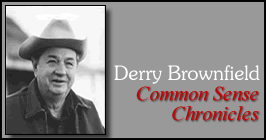


GOVERNMENT POLICY ON FIGHTING FIRES
Derry Brownfield
October 22, 2002
NewsWithViewsKatherine Van Tuyl worked for the US Forest Service from 1974 to 1981. For several of those years she was a wildland firefighter assigned to an engine crew. In those years, forest service policy as outlined in the agency's fire plan, was to suppress every fire before 10:00 am the day following ignition, or before it reached 10 acres in size. In 1977 the ten-acre 10:00 am Policy - both went out the window and fires began to be managed by prescription. Fire Suppression became fire management. In 1988 when lightning started the fires in Yellowsone the fires were allowed to "run their natural course" and the last fire burned until the snow fell. By that time 793,880 acres or 36% of the National Park had gone up in smoke. Public reaction was intense and park staff went into overdrive to explain the positive benefits of fire. In 1994, 34 human lives were lost to devastating fires.
Using politically correct green double-speak the Park Service states "fire was part of a larger problem, one of several symptoms of Natural ecosystems becoming increasingly unstable due to altered ecological regimes," at which time it began to focus on "landscape-level resource management," and the need to involve "all affected landowners and stakeholders." All this green-speak jargon means, "let-her-burn."
The year 2000 was a record year for burning our nation's natural resources and 9,499,511 acres of valuable timber went up in flame. Not only did we lose millions of dollars worth of lumber but the government also spent $1.4 billion in fire "suppression."
Four different government agencies are now involved in fire management: the US Fire Service, National Park Service, Bureau of Land Management and the Bureau of Indian Affairs. Regardless of how much taxpayer money goes into these agencies, don't expect them to come running to put out a fire that may be heading towards your home. You must first understand "wildland urban interface." This is the area where human development meets or intermingles with the wildlands. Each agency has developed plans that detail large areas where suppression efforts will NOT be made. If your home is in the mountains, your set of corrals or your community church is in one of these areas, the feds are going to italix let it burn. (end of italix) Federal policy states; (underline) structure protection is the responsibility of local, county and state fire organizations. end underlining Policy also states that fire will be used as the "change agent" and federal agencies will not suppress fire within the wildland urban interface.
Our own government is squandering our nation's wealth and at the same time trying to rid the land of as many stakeholders (landowners) as possible. It's part of Agenda 21 of the Biodiversity Treaty developed ten years ago at the Rio Convention on Sustainable Development sponsored by the United Nations. If we are not about to become willing sellers or signers of conservation easement, then the government can burn us out. After all - we must be moved into sustainable communities and fire is another way of getting us off the land.
© 2002 Derry Brownfield, All Rights Reserved
Derry Brownfield was born in 1932 and grew up during the depression. He is a farmer and a broadcaster. Derry attended the College of Agriculture at the University of Missouri where he received his B.S. and M.S. degrees. He taught Vocational Agriculture several years before going to work as a Marketing Specialist with the Missouri Department of Agriculture. Derry served as Director of the Kansas City Livestock Market Foundation at the Kansas City Stockyard prior to establishing himself in farm broadcasting.
Derry started farming when he was 16 years old and received the Future Farmers of America State Farmer degree in 1949. Since that time the Brownfield Farm has grown to over 1000 acres maintaining a herd of 200 registered Charolias cows.
In 1972, Derry and his partner established the Brownfield Network which now serves 250 radio stations throughout the Midwest with news and market information.In 1994, Derry started his own syndicated radio talk show and he is one of the most popular radio talk show hosts in America. The Derry Brownfield Show can be heard on approximately 80 radio stations in 23 states. With his entertaining sense of humor and witty commentary he has captured audiences for over 30 years. His ability to present an informative talk show while being light and colorful is why he has a large loyal listening audience.
Derry Brownfield is a practical farmer, a practical business man and a very entertaining speaker. He travels extensively throughout the country speaking about his common-sense point of view. Web Site: www.derrybrownfield.com